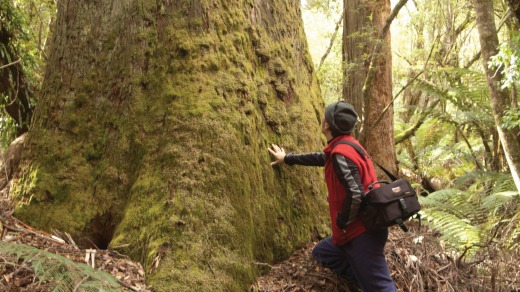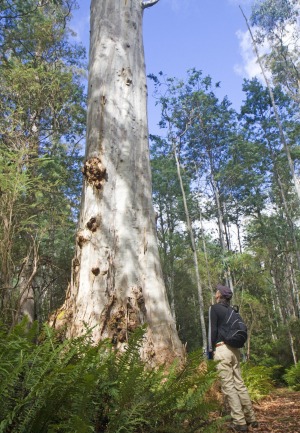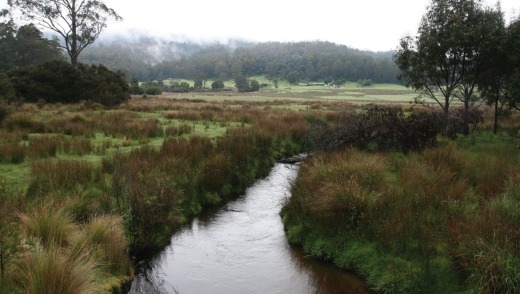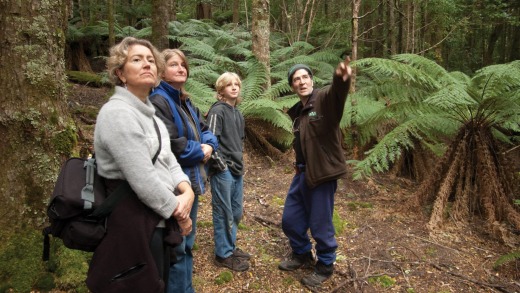
At Tasmania's Forest Walks Lodge there's no television, but who needs it with this cinematic view? In every direction there's bush, mountains and hills. Step from the property and you're almost immediately into World Heritage-listed forest.
One of northern Tasmania's most prominent mountains, Quamby Bluff, rises behind the lodge, and through the windows there's a western – the craggy line of the Great Western Tiers – that plays every day.
Though it's just 20 kilometres south of Deloraine, in remote Jackeys Marsh, the lodge feels generations away. There's no phone coverage and no Wi-Fi. Instead there are slopes of King Billy pines and pencil pines rising into alpine vegetation, and pockets of centuries-old rainforest.

"From an interpretive perspective, there's so much variety here," owner Rosemary Norwood says. "In the south-west (of Tasmania) the forests are quite uniform and in the Tarkine they're uniform, but here there's so much variety."
The lodge's setting is matched by its ecological ethos. The building is constructed in a shallow arc to trap sunlight and heat. A north-facing stone wall absorbs the heat of the day and releases it through the night, helping the lodge maintain a constant, comfortable temperature through winter and summer. Electricity is generated by solar panels, with a water turbine for cloudy days. The lodge's rugs are hand-woven by a neighbour.
When I wake, the Great Western Tiers are staring through my window. After six weeks without rain – almost a drought in these parts – showers have fallen overnight and the land has immediately sprung to life. Fairy wrens bounce about the tussocks, and the air is rich with the scent of eucalyptus oil.

"My daughter worked for a year in Antarctica as a research assistant and she said that when they sailed back they could smell Australia – the eucalypts – from 400 kilometres away," fellow owner Sean Cadman says.
Seemingly hidden even from the rest of Tasmania, Jackeys Marsh is a mosaic of farmland and natural forest. It's been home to seven sawmills, and the original trail on to Tasmania's Central Plateau from the north – the hand-built Warners Track – began its climb here.
Sean and Rosemary moved to Jackeys Marsh in 1980 to establish a community: "Basically a bunch of ageing hippies," Sean says – and they have been walking its forests and mountains for the last 35 years.

Walking opportunities are a key feature of the area, and Sean, a former executive with the Wilderness Society, offers a trio of guided walks. They range from an easy rainforest walk to a day-long ascent of the Great Western Tiers.
I join Sean on his half-day Wild Forest Walk, wandering across the slopes of Quamby Bluff. For much of the day we'll be walking off-track, but the routes are imprinted in Sean's mind. "I could walk through here in the dark," he says.
We'll pass through six distinct forest types, rising up the slopes through a mass of fallen silver wattles and into gullies thick with rainforest.

"Here, you just about have to beat the rainforest back with a stick," Sean says as we pause low on the slopes. "It's actually invading into grassland here. It's a very fast process – here, you can go from grassland to rainforest in 60 years."
A bronzewing pigeon chants in the distance, but as we continue to climb, the mountain falls silent.
"There's not much animal or birdlife here," Sean says. "It's all about the forest but, hey, it's an 80-million-year-old forest so it deserves it. This is true wild forest."
Back at the lodge at walk's end, I while away the remains of the day in the communal lounge, which has a library of natural history books and novels. Sean, who studied food technology at university, heads to the kitchen.
At Forest Walks Lodge food is almost as much a feature as the forest. Sean and Rosemary strive to serve only Tasmanian produce, and food kilometres are sometimes almost counted in metres. One night Sean bakes a ham bought from a neighbouring farm, and there's a duck egg salad from the birds that stroll the yard.
Another night there is venison from a Mole Creek farm, marinated in red wine for eight hours and slow-baked for four hours. Vegetables come from the lodge's own Garden of Earthly Delights.
"The two loves of my life, apart from Rosemary, are the environment and food," Sean says. "Here, I get to be a part of both."
As dinner rolls into its third course – homemade vanilla bean ice-cream with cherry chips – there's not a sound in the valley. The setting sun begins to illuminate the escarpment of the Great Western Tiers. The lodge's nightly TV show has begun.
www.discovertasmania.com.au
www.greatwesterntiers.net.au
Qantas and Virgin Australia fly to Launceston from Melbourne and Sydney. Forest Walks Lodge is about a one-hour drive from the airport.
Rooms are between $140 and $200 a night, with a three-course dinner $50 a person. Guided walks range from $55 to $175; see www.forestwalkslodge.com.